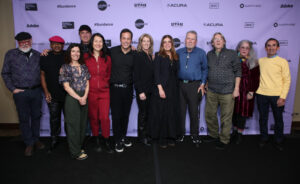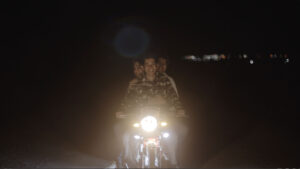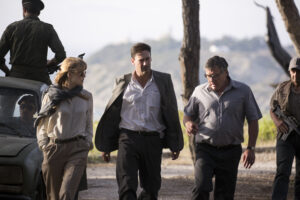Sundance Institute
We the Animals is a Magical Fever Dream Tracking a Volatile Childhood

The first narrative film by veteran documentary director Jeremiah Zagar,
We the Animals tells the story of three young brothers living with their
tempestuous parents in a wooded upstate New York enclave. As their
parents violently fight and passionately reunite, the boys are often left to
fend for themselves. The youngest is a sensitive burgeoning artist named
Jonah, and his wide-eyed point of view and furtive, sensually exploratory
illustrations serve as the heart of the film.
After a screening at the Redstone Theaters on Thursday afternoon, Zagar talked about adapting Justin Torres’ novel
into a magical realist fever dream shot on vivid and grainy 16mm film. After reading the book in one sitting, Zagar
called Torres and said he didn’t want to change anything about the book. He put the book into screenplay format and
thought that would be enough. “Then over the years we realized that the translation — I like to call it a translation
not an adaptation — would have to become more cinematic. We’d have to figure out how to make the book cinema,” he
said.
On Her Shoulders
In the U.S. Documentary Competition entry On Her Shoulders, director/cinematographer/editor Alexandria
Bombach follows genocide survivor and emerging activist Nadia Murad as she navigates the grueling terrains of mass
media and international diplomacy in order to spread the word about the suffering and displacement of her people, the
Kurdish Yazidis of northern Iraq. Nadia travels from city to city to conduct interview after interview, speak to
countless politicians and strategists, and finally address the UN General Assembly, each time revisiting the
unspeakable trauma that she has lived through: ISIS murdered most of her family and brutally raped her before she
managed to escape. Through it all, Bombach focuses on the toll it takes on a 23-year-old girl who never wanted to
leave her humble village. Alongside Nadia throughout these travels is Murad Ismael, her translator and confidante as
well as the founder of the nonprofit organization Yazda, which advocates on behalf of the displaced Yazidis.
At the film’s world premiere last Saturday at The Ray Theatre, Bombach, who was joined by her production team along
with Ismael, talked about the breakneck aspects of shooting on the road, with destinations often changing at the last
minute and vantages for the camera arising just as spontaneously. “I would catch Nadia laughing at me because I would
just run and slide into place,” she said. But the constantly changing, always moving nature of the production spoke
to what Bombach’s subject was going through. “Once I was with Nadia and saw her tell her story over and over again, …
you could see it take a piece of her. It was still so alive—alive because the Yazidis are still suffering, she’s
still suffering through this whole thing,” she said. “I wanted it to be a stable living memory of what she’s
experiencing every day.”
The Price of Everything
In The Price of Everything, which premiered in the U.S. Documentary Competition, filmmaker Nathaniel Kahn
offers a look at the place where high art and commerce meet — and in the process provides an illuminating exploration
of what we as a society choose to value or not. Besides interviews with high-end collectors, Kahn’s camera completely
immerses viewers into the world of contemporary art with visits to artists both remarkably successful, such as Jeff
Koons, and the lesser known, such as Marilyn Minter. Kahn gets their opinions about the auction world (Minter admits
that sometimes women don’t get their proper respect until they’re either old or dead) and even offers a couple
opportunities to watch them work. The director sets out to determine what society loses when modern masterpieces,
selling for astronomical sums, often disappear into private collections away from public viewing. His film will
premiere on HBO later this year, but he also has plans to take it around the country to show at museums and in
classrooms.
Kahn, who comes from a family of artists, said he wanted his new doc to be a mosaic in the style of Robert Altman’s
masterwork Nashville. “There’s not a singular character; it’s multiple characters,” he insisted. “There are
intersecting characters and they come back and you get to know them. They all have their arcs.”




